Coral cover on Caribbean reefs has declined precipitously over the last few decades, e.g.; Gardner et al. 2003 (Science PDF here):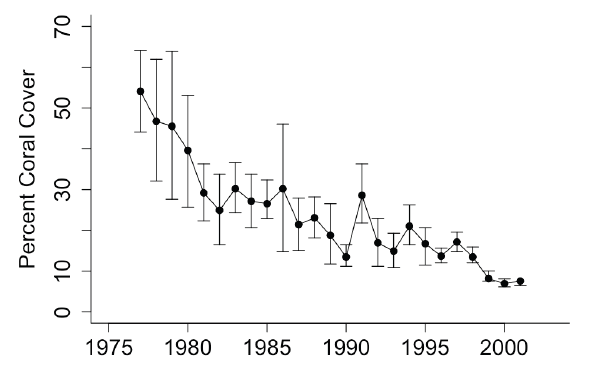
and Schutte et al. 2010 (MEPS PDF here):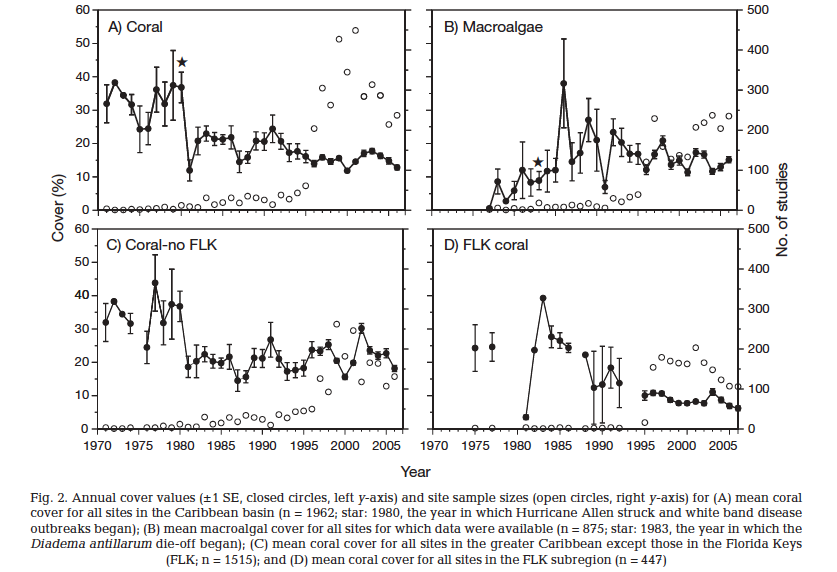
Also see Hughes 1994, Cote et al. 2005, and Jackson et al 2014. There is substantial evidence that human-caused ocean warming is the primary cause of this loss of reef-building corals on most Caribbean reefs:
1) The temporal pattern of decline is concordant with the hypothesis that warming caused most Caribbean coral loss. Modern, human-caused ocean warming started around 1920 and began to accelerate in the late 1960s. Across the Caribbean (as well as globally) regional average coral cover began to decline roughly 10 years later (~ in the late 1970s-early 1980s, sampling is sparse during this period so it’s impossible to be more precise).
The Caribbean has warmed by nearly 1C just since the mid-1980s Chollett et al 2012. The mean trend is 0.29 °C / decade, 1985-2009:
There are also remarkable long-term in situ temperature records for the Florida Keys that document warming over the last century, and a roughy 1C increase in August SST since the mid-1970s (from Kuffner et al 2014):
Although a coarse-grained approach, this is the starting point for climate change attribution based on IPCC criteria, i.e., a 30 year or greater record of temperature and a potential response (in this case coral cover). Although other factors could explain the observed coral loss, we can say with some certainty that it occurred while the region was warming. It is also evident that regional coral cover has been dropping in a somewhat stepwise manner, following temperature-related impacts (from Aronson and Precht 2006):
Moreover, the timing of the primary alternative explanation for Caribbean coral mortality – an increase in macroalgae – suggests the seaweed bloom was a response to and not a cause of the observed mass-coral mortality, i.e., cover cover collapsed several years before the macroalgae increase (see graphic from Schutte et al above).
2) Spatiotemporal coincidence of anomalously high ocean temperatures with coral bleaching and mortality. Hundreds of studies going back decades have documented mass-bleaching and subsequent coral loss on Caribbean reefs. For example, Winter et al 1998 related the timing of extreme SST with mass bleaching in Puerto Rico, initially in 1969 then again in 1987, 1990 and 1995:
By the mid-1990s, there had been enough mass-bleaching events for Winter et al to work out coral bleaching thresholds and their dependence on both the magnitude and duration of the warming anomaly (a concept first developed by Tom Goreau Jr, Peter Glynn and others, that led to the “Degree Heating Week” metric and concept, now widely applied in coral reef science).
McWilliams et al 2005 found that bleaching coincided with warm months and years across the Caribbean between 1983 and 2000:
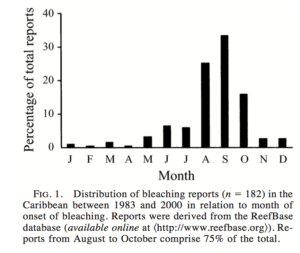
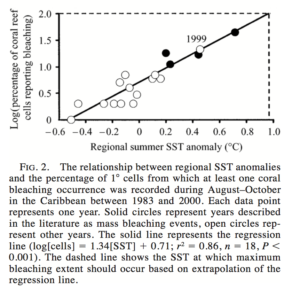
And that the severity of the anomaly was a good predictor of both the geographic extent of mass-bleaching and the average percentage of coral colonies observed bleached (i.e., local and regional dose responses):
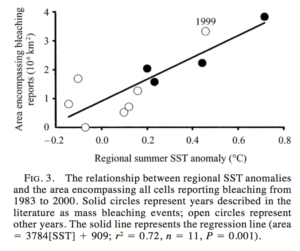
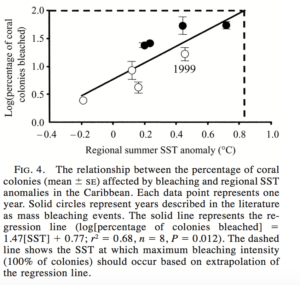
One of most comprehensive accounts of Caribbean mass bleaching is the monograph by Ernest Williams and Lucy Bunkley-Williams (published in the Atoll research bulletin in 1990). Nobody could read – or even skim – this scholarly masterpiece and still argue warming and bleaching have not been important drivers of Caribbean coral loss. The account is incrediby detailed and foresaw a lot of the work that was repeated in following decades. For example, they documented which taxa bleached first during events from 1986-1989:
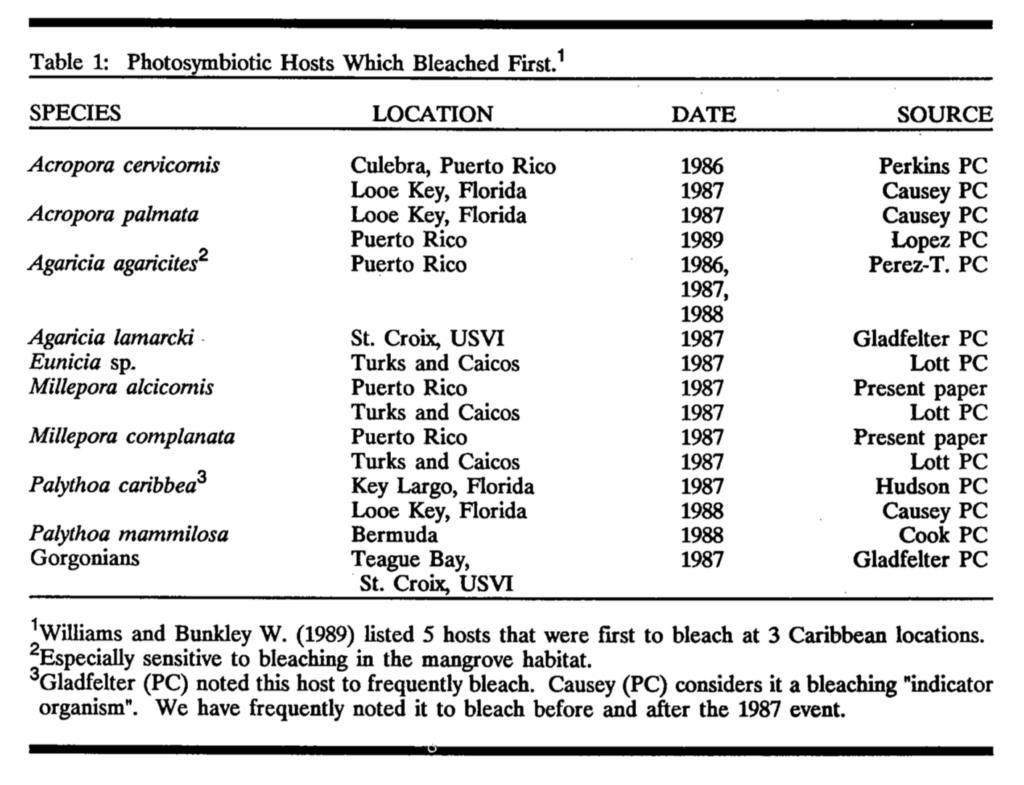
Locations for which coral mortality was observed include The Bahamas, the Florida Keys, Columbia, Puerto Rico, the US Virgin Islands, Turks and Caicos, Panama, Curacao, St. Lucia, and Jamaica. (It made me smile to see the names of so many prominent leaders in the field as the sources of these observation, including Lang, Jaap, Gladfelter, Woodley, Causey, and Hudson. Also see this piece in the NYT about Caribbean bleaching of 1987 – it’s fascinating to read some of the views on the causes of bleaching as the field just started grappling with mass coral mortality, e.g., Nancy Knowlton was already pushing the idea it had more to do with cumulative impacts while Judy Lang pointed out that even corals on remote reefs across the Bahamas had bleached.)
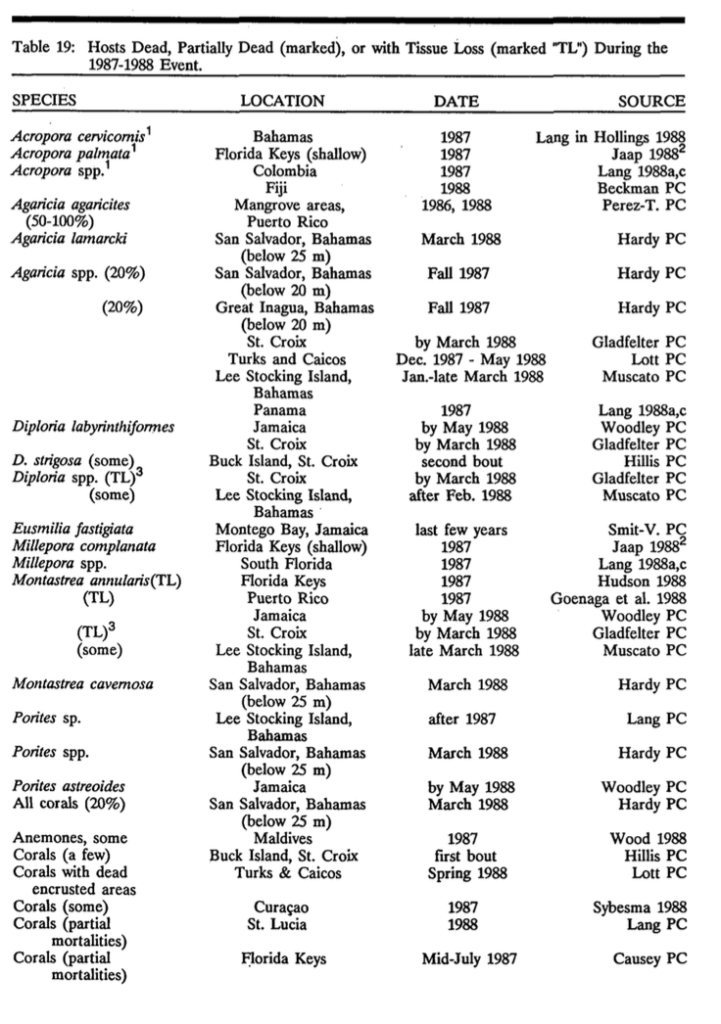
Much of this history is described in the excellent review of coral bleaching by Baker et al 2009, which clearly indicates bleaching was occurring globally, including across the Caribbean:
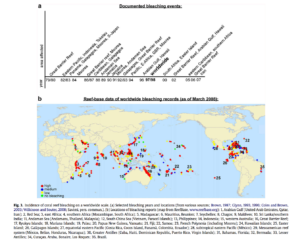
In 1998 oceans temperatures reached new modern highs, triggering mass bleaching globally, including across the Caribbean; e.g., on the Belizean Barrier Reef (Aronson et al 2002) where SST anomalies of >1C caused coral cover to drop by 40%:
Then in 2005, a massive warm blob sat over the southeastern Caribbean, causing extensive bleaching in the Virgin Islands and numerous other locations:
An event extremely well-documented by Eakin et al (2010) (Also see this):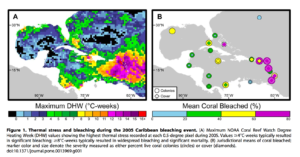
And again in 2010, another well-documented mass bleaching event hit the region, including Tobago, Puerto Rico, the USVI, and Curacao:
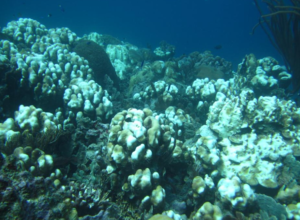 Mass-bleaching of Orbicella annularis in Curacao in 2010, from Vermeij 2012.
Mass-bleaching of Orbicella annularis in Curacao in 2010, from Vermeij 2012.
This was followed by more localized bleaching events in 2014 and 2015 and 2016 and so on. For example, there was severe bleaching (of what little coral remained) in the Florida Keys in 2014 (Manzello 2015):
There are dozens (and likely hundreds) of published papers, including numerous regional compilations, documenting coral bleaching and it’s impacts across the Caribbean over a 30 year period. This evidence alone supports the inference that ocean warming is an important driver of Caribbean coral bleaching and loss.
3) Coincidence of anomalously high ocean temperatures with coral disease outbreaks. Caribbean reef scientists broadly agree that coral disease outbreaks have been a primary cause of Caribbean coral loss (e.g., Aronson and Precht 2006). Caribbean reefs were dominated by corals in the genera Acropora and Orbicella for thousands of years. That is until the late 1970s / early 1980s when a regional outbreak of white band disease wiped out Acropora palmata and Acropora cervicornis (Aronson and Precht 2016). This was followed in the late 1990s by the beginning of the yellow band outbreak in Orbicella, which waned around 2010 after host population density had crashed. Several studies suggest there is a causal link between temperature, ocean warming, disease severity, and the loss of these two critical reef-building genera. First, based on data collected by Ernesto Weil, Harvell et al 2009 reported that lesion growth rate and prevalence of yellow band disease in Orbicella was related to temperature:

Rogers and Muller (2012) reported that the incidence of white pox and white band disease in Acropora palmata was related to temperature:
Additionally, Randall and van Woesik 2015 found clear links between several aspects of ocean warming and white band outbreaks in both Acropora palmata and Acropora cervicornis.
Finally, Precht et al 2016 reported a high prevalence outbreak of white plague disease, infecting numerous coral species, that occurred during the record high temperatures of mid-2015 in south Florida:
4) Tank experiments linking temperature with bleaching and mortality. Countless aquarium experiments have mechanistically linked temperatures beyond the thermal optima with bleaching, mortality, reduced calcification rates, and other fitness indicators. This extensive laboratory experimental work provides strong evidence that the observed association between warming and coral mortality could be mechanistic.
5) Species-specific patterns of coral loss suggest warming, bleaching, and disease, rather than macroalgae, are the cause of Caribbean coral loss.
The coral species for which absolute cover has decreased across the region are those that are most susceptible to warming, bleaching, and disease. Principally, Acropora spp., Orbicella spp., and other massive species such as brain corals. One species in particular that hasn’t declined, Siderastrea siderea, is far less sensitive to thermal stress. If macroalgal overgrowth (and not warming, bleaching, and disease) was the primary driver of coral loss, you wouldn’t expect this pattern – and you certainly wouldn’t predict that massive boulder and fast-growing and massive branching colonies would be the most sensitive to macroalgal overgrowth.
6) Protected areas have not diminished coral loss. Numerous studies have found that effectively managed Caribbean MPAs have not reduced coral loss and warming-related declines are evident regardless of local protections, macroalgae, or parrotfish biomass. A good example is the Florida Keys, where the best-managed reserves in the region still failed to mitigate coral decline (from Toth et al 2014):
Likewise, Jackson et al 2014 found that coral loss was unrelated to macroalgal cover and parrotfish biomass:

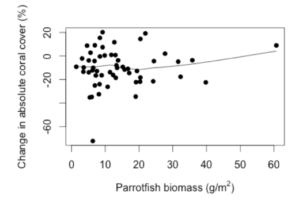

It’s also striking how little macroalgae there is in the countless images of coral bleaching across the region. Just look at the pictures above or google “bleached coral Caribbean”. These bleached colonies are not dying because of sponge-microbe interactions, chemicals released from seaweed, and certainly not from macroalgal overgowth (obviously). They’re also not being smothered by sediment from coastal agriculture. That’s not to say these threats aren’t real. But these corals are dying simply because ocean temperatures slowly rose to 0.5-1C greater than recent summertime highs.
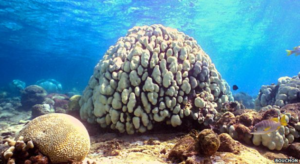
7) Reef isolation from local human impacts has not diminished coral loss. If local impacts (e.g., fishing, algae, and pollution) were the cause of coral decline or if they exacerbated bleaching you’d predict that coral loss would be greater on reefs adjacent to larger human populations (where local impacts are greater). Abel Valdivia and I found that wasn’t the case globally, and Jackson et al reported the same is true for Caribbean reefs:
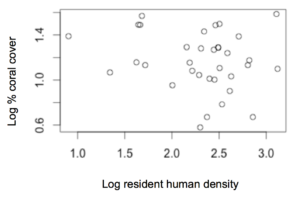
In the Caribbean, reefs isolated (i.e., not experiencing) the local human impacts described by some to be the main causes of recent coral mortality do not differ in coral cover. This is evident if you’ve worked on isolated Caribbean reefs and I know its surprising, but its the reality we’re facing. This is strong evidence that we cannot simply blame land clearing or overfishing by local communities for coral decline. The most striking Caribbean example I know of is Jardines de la Reina or Gardens of the Queen. Despite amazing, near-pristine predatory fish biomass, and little if any local impacts, coral cover is only 18%.
Epilogue: Why bother reviewing this science? It seems crazy that I just spent my entire Saturday writing a blog post about science that I assume everybody in the field is familiar with. Yet I keep running into statements indicating a lot of our colleagues, including some of the leaders in the field, either don’t believe or aren’t aware of this body of literature. So instead of marching for science today, I blogged for science. Hostility towards science from conservative politicians and business interests is certainly a real threat. But in coral reef science, so is the dismissal of science by scientists.
“The three main drivers of degradation are pollution, overfishing, and, increasingly, climate change. I did my PhD at Johns Hopkins University in Baltimore looking at Jamaican coral reefs. Caribbean reefs became degraded much earlier than elsewhere due to runoff following land clearing, mostly for sugar cane, and they are also very heavily fished. So there are few fish left, which means that when the coral die, they are rapidly covered with seaweed rather than with new corals — because there are not enough herbivores, like fish or sea urchins, to eat the seaweed. Tragically, the Great Barrier Reef is rapidly catching up with the Caribbean. But the cause in Australia is different — in our case it is entirely due to the warming water.” – Terry Hughes
First, while coral cover in Caribbean reefs appears to have begun to decline somewhat earlier than on the GBR, the difference is only a few years (if even that; see the update below) (also see this post on the matter). Moreover, the very low sample size (small number of reefs being surveyed annually) means there is great uncertainty about the timing of coral loss before ~ 1985.
Second, its odd to see an explanation for the die off of elkhorn coral around a single island applied to the entire Caribbean. It also doesn’t make sense: how could deforestation cause a well-documented mass coral die off 500 years later? Precisely as ocean temperatures were peaking and the corals had turned white from bleaching or disease? Wouldn’t the scientists have noticed the corals they were studying being buried by sediment? This idea is presumably based on Lewis (1984), who suggest land clearing was one explanation for the mass mortality of elkhorn coral of the shallow fringing reef around Barbados. Yet radiocarbon dating by Macintyre et al. (2007) found that most of the fossil corals on the present day reef crest were killed between 4,500 and 3,000 years ago, likely by storms. (Also see this by Aronson and Precht). That doesn’t mean early land clearing didn’t have an impact in the Caribbean and elsewhere. But the question at hand is what caused contemporary coral decline. Which the coral trend data indicate happened more or less simultaneously globally (give or take a few years) in the late 1970s and early-to-mid 1980s.
Third, it isn’t true that GBR coral loss is “entirely due to the warming water“. Just as in the Caribbean, there are well-documented impacts of predator outbreaks (e.g., COTS), storms, and disease (see attribution of year and sector-specific loss in the graphic above). Additionally, early land clearing for agriculture is thought to have led to increased sedimentation that buried many coastal reefs of the GBR nearly a century ago (Roff et al 2012). According to De’ath et al (2012), mean GBR coral cover was already only ~ 16% by ~ 2010 and regionally, coral cover “collapsed” roughly 20 years before the mass bleaching of 2016!
Anyway, I really don’t understand it. Global warming didn’t just start impacting coral reefs in 2016 – this has been going on for decades. I was nearly 20 years younger when I first witnessed mass-bleaching in Palau in 1998. It’s not just the GBR being impacted. Hundreds of scientists have witnessed on reefs around the world what Dr. Hughes so powerfully described off northeastern Australia. Why dismiss their observations? And the science described above represents the work of a generation of scientists. I can’t get my head around how or why anyone would summarily deny it, as if it simply doesn’t exist.
Update 1: Here is Fig. 1 from Cote et al 2013:
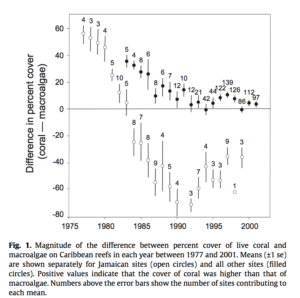

This is an important graphic. It emphasizes not only how unique (and unrepresentative) the Jamaica story is in terms of the severity of the cora-algal phase shift, but also in regard to the timing. Hurricane Allan wiped flatted Jamaican reefs in 1980s, greatly reducing coral cover. This has led to the perception that coral cover collapsed across the Caribbean the same year – but the data tell a very different story of a more gradual decline over the subsequent 30 years, really beginning around 1983 or 84ish.

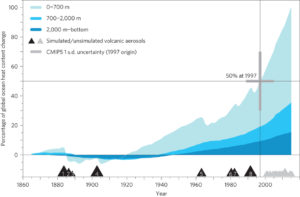
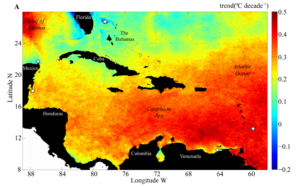
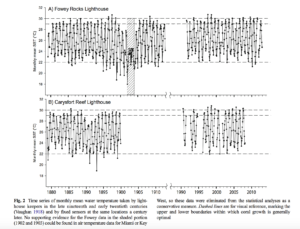
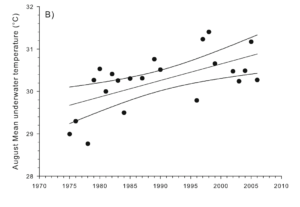

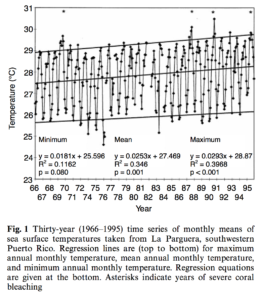
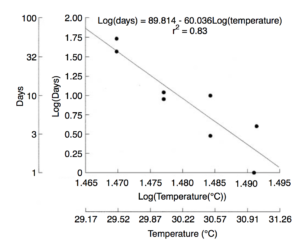
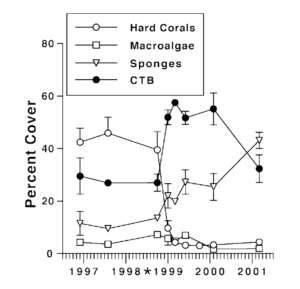
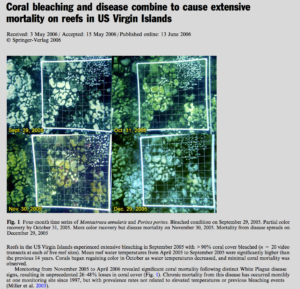
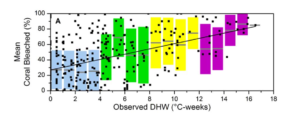

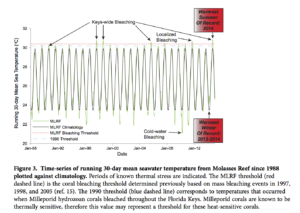
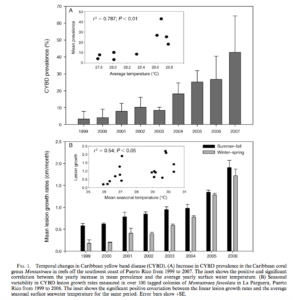

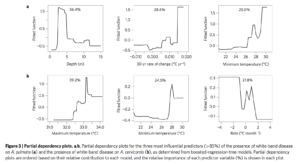
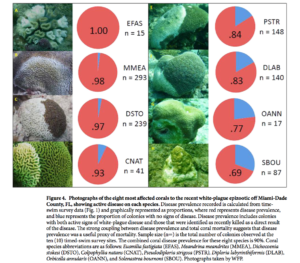
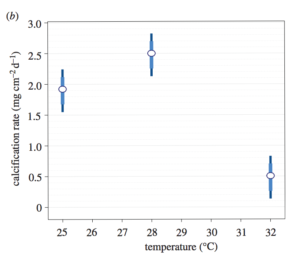
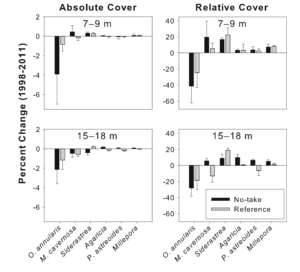
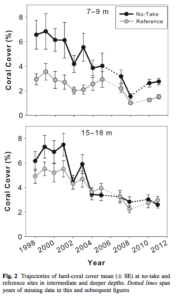
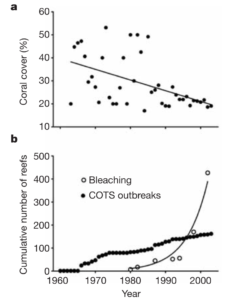
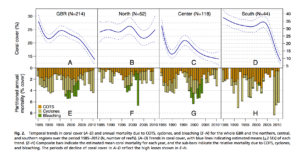
Leave a Reply